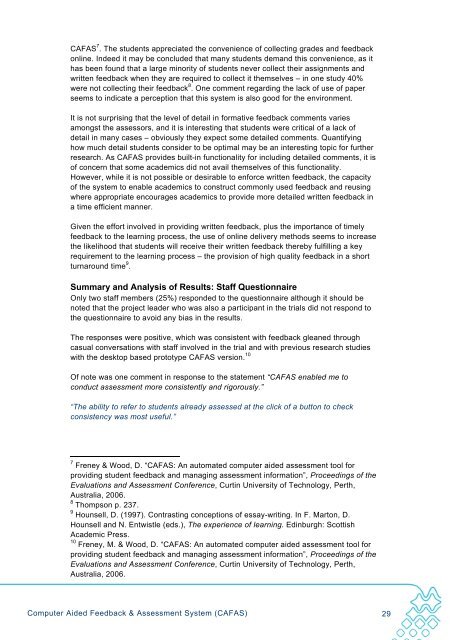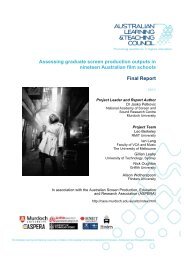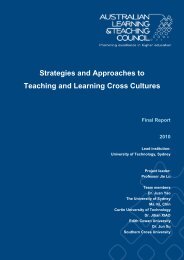PP654 UniSa Freney - Final Report Feb 2010.pdf - Office for ...
PP654 UniSa Freney - Final Report Feb 2010.pdf - Office for ...
PP654 UniSa Freney - Final Report Feb 2010.pdf - Office for ...
Create successful ePaper yourself
Turn your PDF publications into a flip-book with our unique Google optimized e-Paper software.
CAFAS 7 . The students appreciated the convenience of collecting grades and feedbackonline. Indeed it may be concluded that many students demand this convenience, as ithas been found that a large minority of students never collect their assignments andwritten feedback when they are required to collect it themselves – in one study 40%were not collecting their feedback 8 . One comment regarding the lack of use of paperseems to indicate a perception that this system is also good <strong>for</strong> the environment.It is not surprising that the level of detail in <strong>for</strong>mative feedback comments variesamongst the assessors, and it is interesting that students were critical of a lack ofdetail in many cases – obviously they expect some detailed comments. Quantifyinghow much detail students consider to be optimal may be an interesting topic <strong>for</strong> furtherresearch. As CAFAS provides built-in functionality <strong>for</strong> including detailed comments, it isof concern that some academics did not avail themselves of this functionality.However, while it is not possible or desirable to en<strong>for</strong>ce written feedback, the capacityof the system to enable academics to construct commonly used feedback and reusingwhere appropriate encourages academics to provide more detailed written feedback ina time efficient manner.Given the ef<strong>for</strong>t involved in providing written feedback, plus the importance of timelyfeedback to the learning process, the use of online delivery methods seems to increasethe likelihood that students will receive their written feedback thereby fulfilling a keyrequirement to the learning process – the provision of high quality feedback in a shortturnaround time 9 .Summary and Analysis of Results: Staff QuestionnaireOnly two staff members (25%) responded to the questionnaire although it should benoted that the project leader who was also a participant in the trials did not respond tothe questionnaire to avoid any bias in the results.The responses were positive, which was consistent with feedback gleaned throughcasual conversations with staff involved in the trial and with previous research studieswith the desktop based prototype CAFAS version. 10Of note was one comment in response to the statement “CAFAS enabled me toconduct assessment more consistently and rigorously.”“The ability to refer to students already assessed at the click of a button to checkconsistency was most useful.”7 <strong>Freney</strong> & Wood, D. “CAFAS: An automated computer aided assessment tool <strong>for</strong>providing student feedback and managing assessment in<strong>for</strong>mation”, Proceedings of theEvaluations and Assessment Conference, Curtin University of Technology, Perth,Australia, 2006.8 Thompson p. 237.9 Hounsell, D. (1997). Contrasting conceptions of essay-writing. In F. Marton, D.Hounsell and N. Entwistle (eds.), The experience of learning. Edinburgh: ScottishAcademic Press.10 <strong>Freney</strong>, M. & Wood, D. “CAFAS: An automated computer aided assessment tool <strong>for</strong>providing student feedback and managing assessment in<strong>for</strong>mation”, Proceedings of theEvaluations and Assessment Conference, Curtin University of Technology, Perth,Australia, 2006.Computer Aided Feedback & Assessment System (CAFAS) 29
















